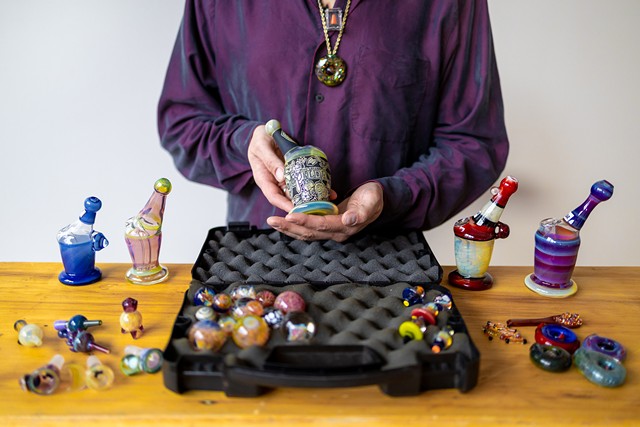[
{
"name": "500x250 Ad",
"insertPoint": "5",
"component": "15667920",
"parentWrapperClass": "",
"requiredCountToDisplay": "1"
}
]
National Geographic recently declared it’s 'The Glass Age,’ with its February issue focusing on the scientific advancements and applications of glass—but of course, there is much more to it than just windows, vials and cell phone screens. Glass is a medium for unparalleled artistic expression. For centuries, glassblowers and artists have learned to play and sculpt with the material, and today’s artisans are experiencing a renaissance akin to the prosperous days of Murano and the Venetian maestros of old. One particular glassy subculture making the most of the moment is pipemakers.
Once resigned to the dark, mysterious domain of head shops frequented by curious teens and long-haired hippies, the noble glass pipe is now an elevated art form of incredible beauty, complexity and skill. Pipemakers at the forefront of their craft have large social media followings (note local rockstars @SlumGold and @GeoffPlattGlass) and can regularly earn high-value commissions, with some pipes selling for thousands (if not tens of thousands) of dollars. This has helped pipemakers transcend a reputation that relegated them to the fringes of the art world. Now, they are lauded by museums and art galleries, coveted by collectors and adored by glass enthusiasts worldwide.
To understand the complex history of pipemaking in this country, one must go back 40 years. In the mid-1980s, legendary flameworker Bob Snodgrass began selling handmade glass pipes at Grateful Dead concerts. By following the band on tour, Bob could sell his pipes to eager Deadheads across the country, and a market was born. In time, head shops embraced the scene and pipes found their rightful home.
But what might have been the start of a glorious pipe-making revolution was squashed as the stigma of cannabis kept the culture hidden. While cannabis remained illegal, mainstream glass was just beginning to take shape and had no room for the heady upstarts. The craft was almost completely crushed in 2003 when the Drug Enforcement Agency unleashed Operation Pipe Dream, a nationwide crackdown on the sale of pipes across state lines (which had, until then, been a boon for pipemakers taking advantage of a new tool—the internet).
Since then, the craft has remained largely underground. “You definitely couldn't talk about it, and it was not acknowledged as an art form,” said pipemaker @EaseGlass of Mecklenburg, NY. Ease has been working with glass since the late ’90s—a time when it was vitally important to adopt an alias to protect your identity and livelihood—and has seen firsthand the impact each change to the law has brought to his profession.
“But the skill level of people doing this has increased dramatically over the last 10-15 years, and that has a lot to do with the relaxation of the prohibition against cannabis,” he said.
Change has been sporadic. Colorado decriminalized recreational cannabis more than 10 years ago, while New Yorkers had to wait until 2021. As a result, artist @HallieCatGlass33, like many in her field, joined the glass migration west from her home in Cazenovia, NY, to Denver, seeking a more inviting community.
“In Denver, we can cater a ‘sesh’ right at a smoke shop and pair pipes with different strains of cannabis to smoke, like a wine tasting or a medicated dinner,” she said. “It’s more than just doing a drug, it’s a ritual. Pipes are very tactile and should be touched and shared, so with legalization, we lose the stigma surrounding our craft and the risk of having our inventory confiscated.”
Hallie believes New York is ready to change, but can the state follow in the footsteps of its more trailblazing siblings? At Mad Hatter’s Hideaway, a smoke shop on Culver Road in Rochester, the back room is filled with glass pipes of all shapes, sizes and colors; everything is protected inside a case like artwork in a museum. Rochester artist @REK.glass calls it “a free stoner museum of glass.” There are hand pipes and scientific water pipes (commonly called bongs). Some functional art glass pipes resemble insects, graffiti, underwater sea creatures, and characters from “Alice’s Adventures in Wonderland,” in honor of the store’s owner. There is even a case with priceless Bob Snodgrass originals—a shrine to the OG himself.
“The Rochester scene is still breathing and starting to thrive once again, even if some local artists live sale to sale or resort to part-time jobs for steady income,” said REK.
These are exciting times for New York, and artists have a reason to stay, hone their craft and build their businesses here. It’s no surprise that the wider contemporary art world is taking notice, too.
That’s the real heart of this new Glass Age—a close-knit community of artists who have persevered through stigma and prosecution. REK is confident they’ll continue to find ways to collaborate, inspire and push their art to the next level.
“We’ll always find a way to keep the torch on and the glass flowing.”
Jon Heath is a contributor to CITY.
Once resigned to the dark, mysterious domain of head shops frequented by curious teens and long-haired hippies, the noble glass pipe is now an elevated art form of incredible beauty, complexity and skill. Pipemakers at the forefront of their craft have large social media followings (note local rockstars @SlumGold and @GeoffPlattGlass) and can regularly earn high-value commissions, with some pipes selling for thousands (if not tens of thousands) of dollars. This has helped pipemakers transcend a reputation that relegated them to the fringes of the art world. Now, they are lauded by museums and art galleries, coveted by collectors and adored by glass enthusiasts worldwide.
To understand the complex history of pipemaking in this country, one must go back 40 years. In the mid-1980s, legendary flameworker Bob Snodgrass began selling handmade glass pipes at Grateful Dead concerts. By following the band on tour, Bob could sell his pipes to eager Deadheads across the country, and a market was born. In time, head shops embraced the scene and pipes found their rightful home.
But what might have been the start of a glorious pipe-making revolution was squashed as the stigma of cannabis kept the culture hidden. While cannabis remained illegal, mainstream glass was just beginning to take shape and had no room for the heady upstarts. The craft was almost completely crushed in 2003 when the Drug Enforcement Agency unleashed Operation Pipe Dream, a nationwide crackdown on the sale of pipes across state lines (which had, until then, been a boon for pipemakers taking advantage of a new tool—the internet).
Since then, the craft has remained largely underground. “You definitely couldn't talk about it, and it was not acknowledged as an art form,” said pipemaker @EaseGlass of Mecklenburg, NY. Ease has been working with glass since the late ’90s—a time when it was vitally important to adopt an alias to protect your identity and livelihood—and has seen firsthand the impact each change to the law has brought to his profession.
“But the skill level of people doing this has increased dramatically over the last 10-15 years, and that has a lot to do with the relaxation of the prohibition against cannabis,” he said.
Change has been sporadic. Colorado decriminalized recreational cannabis more than 10 years ago, while New Yorkers had to wait until 2021. As a result, artist @HallieCatGlass33, like many in her field, joined the glass migration west from her home in Cazenovia, NY, to Denver, seeking a more inviting community.
“In Denver, we can cater a ‘sesh’ right at a smoke shop and pair pipes with different strains of cannabis to smoke, like a wine tasting or a medicated dinner,” she said. “It’s more than just doing a drug, it’s a ritual. Pipes are very tactile and should be touched and shared, so with legalization, we lose the stigma surrounding our craft and the risk of having our inventory confiscated.”
Hallie believes New York is ready to change, but can the state follow in the footsteps of its more trailblazing siblings? At Mad Hatter’s Hideaway, a smoke shop on Culver Road in Rochester, the back room is filled with glass pipes of all shapes, sizes and colors; everything is protected inside a case like artwork in a museum. Rochester artist @REK.glass calls it “a free stoner museum of glass.” There are hand pipes and scientific water pipes (commonly called bongs). Some functional art glass pipes resemble insects, graffiti, underwater sea creatures, and characters from “Alice’s Adventures in Wonderland,” in honor of the store’s owner. There is even a case with priceless Bob Snodgrass originals—a shrine to the OG himself.
“The Rochester scene is still breathing and starting to thrive once again, even if some local artists live sale to sale or resort to part-time jobs for steady income,” said REK.
These are exciting times for New York, and artists have a reason to stay, hone their craft and build their businesses here. It’s no surprise that the wider contemporary art world is taking notice, too.
That’s the real heart of this new Glass Age—a close-knit community of artists who have persevered through stigma and prosecution. REK is confident they’ll continue to find ways to collaborate, inspire and push their art to the next level.
“We’ll always find a way to keep the torch on and the glass flowing.”
Jon Heath is a contributor to CITY.
Latest in Culture
More by Jon Heath
-

ROCHESTER TEN
LISA KRIBSAug 1, 2023 - More »







